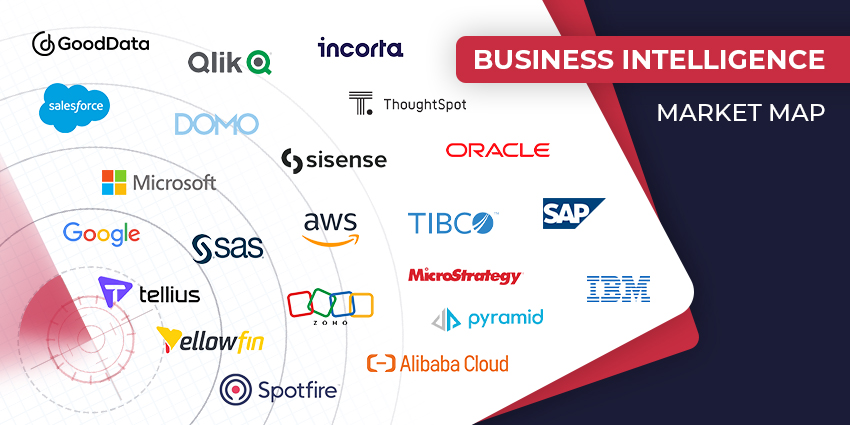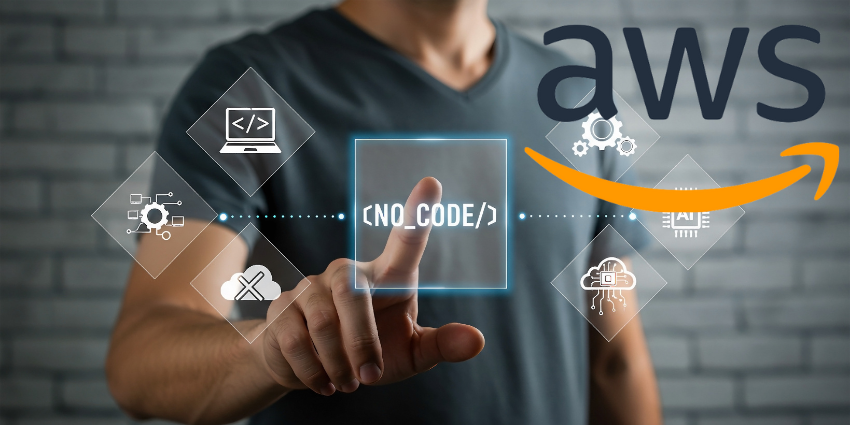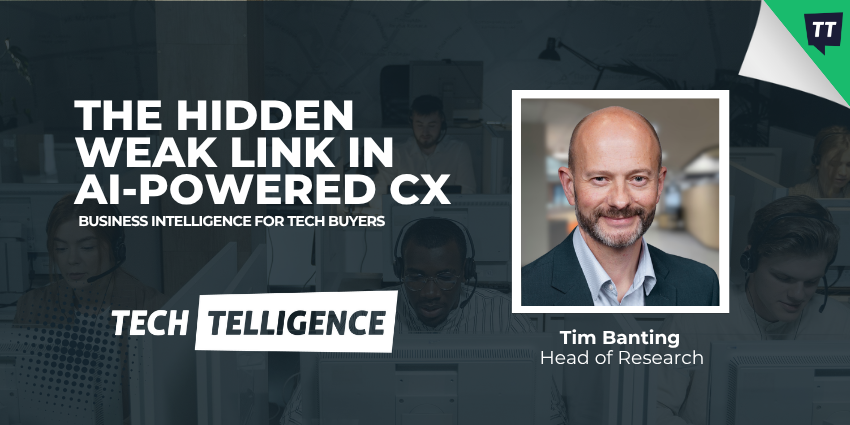In 2025, customer expectations aren’t just changing, they’re accelerating. The companies leading the way aren’t just tracking interactions. They’re building intelligent ecosystems where every touchpoint, every decision, and every customer moment is informed by data.
That’s where the top business intelligence companies deliver value. These platforms help teams act, pivot, and personalize at scale. Whether embedded in the contact center, powering marketing attribution, or guiding product strategy, today’s top BI companies are essential to enterprise growth.
But as the market grows, towards a value of $63.17 billion by 2034, choosing the right vendor becomes more complex. This guide, drawing from the vendors featured in the CX Today Business Intelligence marketplace, aims to simplify the enterprise search.
These are the top business intelligence vendors to know in 2025, what they do, how they’re evolving, and why they matter to enterprise CX.
Top Business Intelligence Companies
The Best Business Intelligence Companies for Smart Insights
The top business intelligence companies in 2025 aren’t just offering reporting tools. They’re building integrated platforms that combine artificial intelligence, real-time analytics, and cross-functional collaboration to drive outcomes across the customer journey.
This list spotlights the top BI vendors helping organizations cut through data noise and turn raw metrics into meaningful decisions. Whether you’re scaling a CX operation, automating insights, or rolling out self-service analytics across teams, the vendors below offer platforms that are ready for complex, high-volume enterprise environments.
Salesforce
Salesforce doesn’t lead with “business intelligence” as a headline, but make no mistake, it’s everywhere in the ecosystem. At enterprise scale, it’s often the glue between data, decisions, and delivery. With Salesforce, companies can discover new ways to enhance the sales pipeline, improve customer journeys, and enhance service delivery.
The company’s comprehensive Tableau platform allows organizations to automate discovery and analysis, leveraging AI models to surface deeper insights from huge volumes of data. In 2025, the real shift is Tableau Pulse, a feature that doesn’t just track metrics but flags them when something changes.
It works well with Data Cloud, Salesforce’s unified data engine, which pulls customer data from CRMs, commerce platforms, and service records. That foundation powers things like AI recommendations, Agentforce strategies, customer journey forecasting, and real-time decisioning across sales and support channels.
Microsoft
Power Technology vendor, Microsoft makes drawing insights from business data simple, with the intuitive Power BI platform.
The solution ensures companies can draw valuable information from multiple sources, including Microsoft platforms like Teams. Plus, it works with intelligent automation and workflow building tools, allowing company to automate a range of discovery processes.
For teams already using Excel, Outlook, Teams, or Dynamics 365, Power BI just slides in. No awkward integrations. This year, Microsoft added more AI to the mix. Copilot for Power BI is getting better at writing reports and visuals based on a quick prompt.
There’s more under the hood, too. Governance controls are stronger now. Admins can tag sensitive data, set access levels, and audit who’s pulling what. That’s a plus for teams dealing with compliance-heavy industries like finance, healthcare, or government.
Qlik
Delivering a host of solutions for business analytics and intelligence, Qlik specializes in data integration, data quality, and reporting. The customizable platform offered by the company can integrate with a huge selection of business tools and cloud services.
Qlik tends to land in two types of enterprise environments: those swimming in fragmented data, and those trying to do something useful with it. The platform works well in both. That’s partly why it keeps showing up on lists of the top business intelligence companies.
In 2025, the big push is around Qlik Staige, the company’s AI and ML suite, now baked into its analytics platform. It helps teams automate insights and even nudge actions through real-time alerts.
Qlik Cloud has also matured. It handles hybrid data architectures better now, and supports direct query, in-memory, or both. This matters for large CX teams juggling cloud warehouses, on-prem data lakes, and operational CRMs all at once.
Domo
Cloud software company, Domo, is responsible for a comprehensive range of business intelligence tools, data integration solutions, and AI applications.
In 2025, the platform has doubled down on self-service analytics, prebuilt apps, and embedded workflows, tools that get insights in front of people without hand-holding from IT.
The UI leans simple, which helps. CX teams can track ticket trends, sales velocity, or voice-of-customer sentiment with drag-and-drop tools. Managers can push those dashboards into Slack or email with scheduled updates. Field teams can access KPIs on mobile without waiting for VPN access.
It’s also worth noting Domo’s push into App Studio, which lets companies build custom analytics tools on top of the BI layer. That means everything from contact center scorecards to account health monitors, tuned to specific workflows and roles.
ThoughtSpot
Technology company ThoughtSpot produces business intelligence analytics software, intended to streamline access to useful insights. The AI-powered platform benefits from a convenient search-engine-style interface, ensuring teams can ask questions of their data without complex coding.
The latest version of ThoughtSpot Sage lets users ask things like, “Which customer segments are dropping in satisfaction this month?” and get a chart, explanation, and suggested action, all in one go. It’s meant for business users who need answers quickly, without chasing analysts or building SQL queries.
Underneath, ThoughtSpot connects directly to cloud warehouses like Snowflake, Databricks, or Google BigQuery. That means the data is always live and updates automatically. Plus, the ThoughtSpot team also offers step-by-step guidance and consulting options to beginners, as well as intuitive webinars.
Sisense
Like many leading business intelligence companies, Sisense supports organizations in building AI-driven insights into their existing systems and processes. The company’s platform supports pro-code, low-code, and no-code solutions, to suit a wide range of companies. Plus, Sisense gives organizations a range of ways to make the most of their data.
In 2025, Sisense is leaning harder into its Fusion Embed platform. This lets teams bring analytics straight into web apps, internal tools, or customer-facing portals. If a CX platform wants to show account health scores to agents in real time, Sisense makes that possible, no platform switch required.
Companies can leverage visualization tools to create graphs and charts about important business processes. Plus, there’s an intelligent alerting system, which ensures businesses can automatically monitor essential KPIs and spot changes quickly.
One standout feature this year is Sisense’s Knowledge Graph, which maps relationships across multiple datasets. This helps surface connections that aren’t obvious at first glance.
Oracle
Technology giant, Oracle, produces a huge range of technology solutions for business leaders. The company’s comprehensive portfolio covers everything from customer relationship management, to data storage and discovery.
The current offering, Oracle Analytics Cloud (OAC), isn’t trying to be the most intuitive platform for brand-new users. It’s built for teams who already live in Oracle environments, finance, operations, logistics, or enterprise CX. That tight coupling gives OAC access to a wide range of data: ERP, HCM, marketing automation, and CRM all under the same roof.
Oracle is focusing on augmented analytics in 2025. The platform surfaces predictions, not just trends, using embedded machine learning models. A CX director, for example, can receive alerts when customer sentiment shifts outside the norm, along with projected impacts on churn or upsell.
Oracle also supports natural language querying now, along with visual data storytelling. These tools are helping non-technical teams dig into data faster.
Looker used to be the BI platform for data teams. Now, under Google Cloud, it’s positioned as something bigger: a semantic layer for enterprise-wide intelligence. In practice, that means CX, sales, ops, and marketing teams can all work from the same definitions.
In 2025, the most interesting evolution is how Looker now connects with Gemini. This allows users to ask questions in plain English, “Which regions are behind on NPS this quarter?” and get clean, visual answers pulled straight from live BigQuery tables. There’s less toggling, fewer exports, and more alignment between teams.
Looker also plays well with non-Google tools. It integrates with Tableau, Power BI, and Sheets, meaning it doesn’t force teams to abandon their habits.
Companies can leverage BigQuery for multi-cloud data warehousing, Looker for business intelligence and embedded analytics, and Connected Sheets for comprehensive analysis.
SAP
Software company SAP competes with leading business intelligence companies with the “BusinessObjects” suite. This centralized suite of solutions combines data reporting and visualisation, with report development and sharing. While the BusinessObjects offering is an on-premises BI layer for data analysis, there are cloud solutions available.
In 2025, SAP has also been shifting attention to SAP Analytics Cloud, a more modern, cloud-based solution that brings together planning, business intelligence, and predictive analytics in one interface.
The real value for CX teams lies in connected data models. These allow sales, service, and marketing teams to forecast outcomes based on real-time inputs from other systems. Want to know how support ticket surges impact retention in retail? Or how delivery delays affect NPS in logistics? SAP ties those threads together.
With built-in features like natural language queries, predictive modeling, and integration with SAP HANA, the platform works well for teams who already rely on SAP for core processes.
TIBCO
Focusing on the development of business intelligence solutions for the digital age, TIBCO supports organizations in accessing historical reports, and real-time dashboards.
The TIBCO platform delivers industrial-strength solutions for tracking performance metrics. Plus, companies gain access to a solution that can adapt to suit their need, in the cloud, on-premises, and at the edge.
TIBCO Spotfire, has evolved from classic dashboarding into a full suite for AI-powered analytics, visual exploration, and real-time event monitoring. One feature that’s getting more use? Streaming analytics. TIBCO can process live data from sensors, CRM logs, or digital interactions and trigger alerts or visual updates in seconds.
Spotfire also comes with built-in data wrangling, geo-analytics, and Python/R integration. That makes it a flexible option for teams who want both visual tools and hands-on access to the guts of the data.
SAS
Analytics software and technology vendor SAS ensures companies from all industries can transform raw data into comprehensive business intelligence. The company’s augmented analytics and business intelligence software is an interactive, AI-driven offering which takes advantage of next-level automation, as well as large language models and generative AI.
The core BI platform, SAS Visual Analytics, offers advanced data exploration, automated insights, and rich storytelling features. It’s not aimed at casual dashboard users. It’s designed for teams that want to model complex scenarios, validate assumptions, and build out predictive use cases that stretch beyond basic KPIs.
With the SAS Viya offering, companies can gain real-time insights into crucial metrics and KPIs, and leverage predictive analytics for rapid business decision making. Plus, the company’s offering works seamlessly with a huge variety of cloud solutions, from AWS, Google, and other market leaders. There’s even the option to build reporting tools into existing software systems.
IBM
Cognos has been part of IBM’s analytics portfolio for decades, but it’s not riding on legacy. In 2025, Cognos Analytics with WatsonX is focused on explainability, automation, and scale, key priorities for CX teams under pressure to deliver measurable outcomes.
One of Cognos’ most useful strengths is how it blends self-service discovery with governed reporting. Teams can run quick queries and build ad-hoc visuals, while IT keeps control over data definitions and source integrity. That mix of flexibility and oversight works well in regulated sectors or multi-region deployments.
The new integration with WatsonX AI and machine learning takes things further. Teams can now ask questions in plain language, get AI-powered insights, and surface forecasts based on customer behavior, ticket history, or sales performance.
Another area IBM has improved is mobile optimization. Dashboards are easier to access on the go, and alerts can be configured to flag anomalies mid-shift.
Yellowfin
Like some of the other top Business Intelligence companies, Yellowfin focuses on making useful insights more accessible to teams of all sizes. With the Yellowfin platform, companies can combine all of their data sources into a single ecosystem, complete with data storytelling tools and automation. Teams can collaborate on comprehensive reports, with AI-assisted natural language querying.
At the center is Yellowfin Signals, a tool that automatically scans your data for changes, spikes, or patterns worth flagging. Instead of building dashboards and hoping someone checks them, the platform pushes alerts to users with full context, charts, explanations, and links to the underlying data.
Also useful is Yellowfin Stories, which lets analysts or CX leaders annotate charts with commentary, screenshots, and external links.
Yellowfin also offers smooth integrations with cloud warehouses and CRMs, plus embedded BI options for companies that want to bring insight directly into apps or customer portals.
Tellius
Tellius is one of the newer names in the top business intelligence companies conversation, but it’s quickly making space for itself by solving a problem most legacy platforms ignore: speed-to-insight for non-technical teams.
The core product combines search-driven analytics with automated decision intelligence. This feature, called Smart Insights, has seen strong adoption in 2025 across CX and customer service teams.
Managers can diagnose performance issues or campaign drops without building reports from scratch. It also helps teams move faster during quarterly planning or incident reviews.
Tellius integrates with major data warehouses like Snowflake, Redshift, and Azure, and can ingest data directly from CRM and helpdesk platforms. There’s a new AI assistant as well, built to generate data stories in natural language, ready for exec reviews or team huddles.
Amazon Web Services
Technology giant Amazon Web Services (AWS) produces various tools for data collection, analysis, and insights. The core BI system offered by the company is Amazon QuickSight, a toolkit designed to eliminate data silos and unify information at scale.
QuickSight allows companies to achieve various business goals through modern interactive dashboards, embedded analytics, and natural language queries. Plus, it comes with access to Amazon Q. The Q AI assistant that lets users type questions and get answers instantly.
Teams ask, “Which product lines are falling behind in customer retention?” and Q returns the data, visualized, explained, and sometimes even projected forward.
QuickSight also powers serverless dashboards, which scale on demand. That matters when CX leaders need to share insights across global teams without worrying about provisioning or backend load times.
Alibaba Cloud
The cloud division of the Alibaba company, Alibaba Cloud, serves the business intelligence needs of companies worldwide with the “Quick BI” offering. The dynamic platform empowers teams to align different sources of data, from SQL servers to local files. Plus, the drag-and-drop solution simplifies the art of data modelling and visualization.
The 2025 version puts more emphasis on self-service dashboards, mobile access, and prebuilt connectors to commerce platforms, CRM systems, and third-party logistics apps, all major priorities for companies working across marketplaces or direct-to-consumer environments.
For CX and marketing teams, Quick BI offers natural language search, interactive reports, and drill-downs that don’t require SQL. With comprehensive control over access permissions, and flexible embedding to allow companies to infuse their existing tools with insights, Alibaba delivers a comprehensive solution.
Zoho
Leading cloud technology and software company, Zoho, delivers a wide range of tools to business leaders, ranging from helpdesks and collaboration tools for teams, to customer service systems. Like some of the other top business intelligence vendors, Zoho delivers its technology through the cloud, in the form of a self-service solution for analysis.
As one of the top business intelligence companies in 2025, Zoho continues to emphasize ease of use with Zoho analytics, and tight integration with the full Zoho stack.
The platform includes Zia Insights, an AI-powered assistant that automatically scans reports and flags outliers or unexpected shifts. It also supports natural language questions. Customization remains a strong point. Zoho Analytics allows for embedded dashboards, custom formulas, blending across multiple data sources, and role-based permissions.
Pyramid Analytics
Specializing in augmented analytics technology for data preparation, data science, and in-depth evaluation, Pyramid Analytics helps companies unlock new decision making strategies. Recognized by analysts like Gartner as one of the top business intelligence companies, Pyramid connects the dots between different data ecosystems, and leverages AI to enhance insights.
The Pyramid Decision Intelligence Platform brings together data prep, modeling, visualization, and machine learning in a single environment. The company’s platform includes the built-in PYRANA direct query engine for simplified discovery sessions.
This year, Pyramid has doubled down on augmented analytics, using natural language querying, explainable AI, and guided simulations to help users understand not only trends, but contributing factors.
MicroStrategy
Enterprise analytics company MicroStrategy produces AI-powered analytics solutions to support companies in making quick, data-driven decisions. The MicroStrategy platform gives companies a comprehensive workstation for collaborative data analysis, as well as a host of tools for building AI-powered analytical apps.
The big news this year is the launch of MicroStrategy AI, a new suite of tools that layers natural language queries, intelligent agent suggestions, and auto-generated insights across its core analytics environment.
MicroStrategy’s longtime strength has been semantic modeling. That continues to pay off in environments where data consistency matters. Whether a report is being viewed by finance, marketing, or service, the metrics hold their meaning.
Another notable feature is the platform’s mobile intelligence capabilities. Field teams, execs, or contact center leads can access secure dashboards and alerts on mobile.
Incorta
Incorta promises companies comprehensive self-service analytical tools, and a robust platform for managing collected data. Powered by smart lakehouse technology, Incorta’s Business Intelligence offering leverages cutting-edge AI and machine learning, with Incora X, as well as offering companes a simple and powerful solution for direct data mapping.
As one of the top business intelligence companies, Incorta ensures its system connects directly to ERPs, CRMs, finance systems, and other business apps, and then delivers insights directly from the raw tables.
This approach supports schema-on-read architecture, which lets CX and operations teams build dashboards on top of live data, even from systems like Oracle EBS, NetSuite, or SAP.
Incorta has also added AI-generated summaries this year, making it easier for business users to translate data into executive-ready language. And its integration with cloud storage (Azure, GCP, AWS) has made hybrid deployments easier to manage.
Spotfire
Branching off from TIBCO, Spotfire combines visual analytics, in-line data wrangling, and data science into a straightforward BI solution. Like many of the top business intelligence vendors for CX teams, Spotfire is experimenting with AI.
The Spotfire copilot can offer product help, document context, auto visualization features, and data interrogation all powered by natural language. Spotfire’s technology is available for deployment on-premises, or in the cloud, and it supports a range of domain-specific applications.
Plus, Spotfire stands out for its ability to handle streaming analytics, allowing CX teams to track sentiment or behavior changes as they happen. That’s especially useful for time-sensitive environments like travel, e-commerce, or media.
GoodData
Looking for scalable, AI-powered data analytics? GoodData could be an ideal choice. The company’s end-to-end analytics platform helps drive better decision making with a combination of ML, AI, and BI insights. Anyone can visualize data or ask questions through a code-based or drag-and-drop UI.
Plus, the platform’s headless architecture means teams can easily embed their full analytics experience into any existing app, platform, product, or portal. There’s also the option to automate deployment, testing, and other practices, with AI-powered, analytics-as-code workflows.
On top of that, GoodData offers dedicated solutions for professional services, software, finance, healthcare, and ESG companies worldwide.
The Business Intelligence Companies Worth Partnering With
There’s no shortage of business intelligence companies promising speed, automation, and insight. Some deliver. Others don’t. The difference usually comes down to how well they fit into the systems you already use, and how quickly they help your teams turn raw data into something useful.
Not every platform is built for the same kind of buyer. Some of the top BI companies on this list are better suited to data-heavy enterprises. Others keep things light, focusing on usability, speed, or cost. A few are great at embedding intelligence into customer-facing tools. Others do a better job surfacing answers for internal teams trying to work faster.
What matters most is alignment. For enterprises the middle of a buying or about to start one, we’ve pulled together a few practical next steps.
- Want deeper insights into market shifts? Grab our latest BI and CX research for straight-talking breakdowns of what’s happening behind the scenes.
- Curious how other teams are solving the same problems? Join the CX Community and connect with real team leaders (not just vendors).
- Prefer to see things in action? Check out upcoming events for demos, Q&As, hands-on walkthroughs.
- Need help navigating vendor conversations internally? Our CX Buyer’s Guide lays out how to frame the conversation, map requirements, and avoid common roadblocks.
For teams trying to connect the dots between data, teams, and outcomes this is where to begin, with the comprehensive guide to Business Intelligence:
Making the right decision, isn’t just about choosing a platform. It’s about clarity, timing, and the right strategy, with the right tools to back it up.







